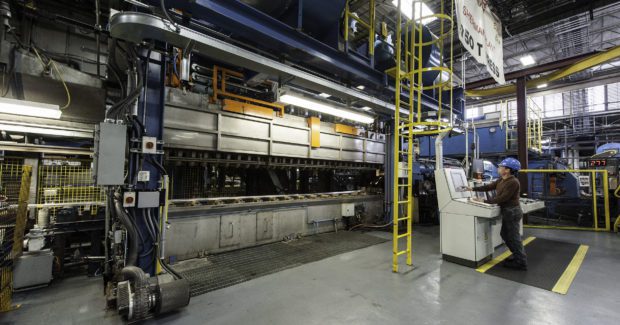Aluminum: The New Metal in Automotive Fabrication
As aluminum costs drop, the material is finding new applications that push the envelope on how much of this metal can be used in the structural makeup of a vehicle – with no end in sight.
Posted: April 18, 2016
Aluminum has been used in the automotive industry for 40 years, but the current move to switch from steel to aluminum in car and truck skeleton and body construction for better fuel efficiency now makes aluminum second only to steel as the most used material in vehicles. As aluminum costs drop, the material is finding new applications that push the envelope on which of these metals will eventually comprise most of the structural makeup of a vehicle. Aluminum use is way up in luxury vehicles such as the Range Rover (which is now around 40 percent lighter than most of its older models), the Audi A8 and A6, the Cadillac ATS and some Jaguar vehicles. And the popular all-aluminum body of the Ford F-150 pickup truck symbolizes the increasing use of aluminum use in mass-market vehicles.
POUND FOR POUND REASONS WHY
Aluminum fabrication is expanding because the metal can effectively help increase vehicle performance, boost fuel economy and reduce emissions quickly, safely, and cost effectively. “When applied to an optimized automotive body structure, aluminum can provide a weight savings of up to 50 percent compared to a traditional mild steel structure. A lower-weight vehicle accelerates better, brakes better, handles better, and can efficiently haul and tow because the engine doesn’t carry unneeded weight,” reports the Aluminum Association (Arlington, VA). “Aluminum use saves the equivalent of 108 million barrels of crude oil in energy compared against a fleet of traditional steel vehicles.”
That’s not all. Pound for pound, aluminum can absorb twice the crash energy of mild steel, and larger crush zones can be designed without corresponding weight penalties. “Because aluminum is lighter, automakers can increase dent resistance by making body panels thicker while still lowering weight,” states the Association. “Aluminum body structures are equal or superior in strength to steel and absorb twice as much crash-induced energy. Primary-structure weight savings also allow other vehicle systems to be downsized, including the engine, transmission, suspension and wheels.” All of this is seen in the high-strength, military-grade all-aluminum F-150 truck: it is 700 lb lighter, goes farther on a gallon of gasoline, and is opening the door to other changes that can further boost fuel economy.
Then there are the environmental advantages. “At the end of a vehicle’s life, nearly 90 percent of the aluminum is recycled, on average,” notes the Association. “Nearly 90 percent of automotive aluminum scrap – more than a half-million tons a year – is recovered and recycled. To place this in perspective, recycling one ton of aluminum saves the energy equivalent of 21 barrels of oil.” On top of that, a Department of Energy study by the Oak Ridge National Laboratory (Oak Ridge, TN) found that an aluminum-intensive vehicle can achieve up to a 20 percent reduction in total life cycle energy consumption and up to a 17 percent reduction in CO2 emissions.
For automotive suppliers, the shift to aluminum parts used throughout the vehicle will continue to grow, beyond the body skeleton, the hood, the trunk, doors, bumpers, wheels, transmission casings, cylinder heads, suspension joints, into whatever other components make sense – a trend that demands shops to pay special attention “under the hood” of the aluminum fabrication process, in the tasks of careful material handling and finishing. Here is some of the latest equipment to help them in those areas:
Vacuum Tooling For Automotive Body-In-White Assembly
Shops can use Modular Automation Tooling from Piab to quickly construct flexible and adjustable vacuum gripper/fixture tooling, robot end-effector tools or other fixturing for any type of automation equipment.
Hydraulic Tilt Tables For Automotive Applications
Ideal for demanding environments, economical and cost-effective Standard and Wide-Width heavy duty hydraulic tilt tables from Verti-Lift tilt up to 6,000 lb from zero to 90 degrees.
Handle Sheet Metal with Care
FIPALIFT vacuum tube lifters from FIPA allow a single person to safely lift, transport, and precisely position up to 639 lb of structured, smooth, oily, dry, non-magnetic, and even hot sheet metal with minimal physical exertion and without the risk of dents, scratches, or exposure to paint-impairing substances.
Finishing Aluminum
Enduro-Flex 2-in-1 TURBO finishing flap discs from Walter Surface Technologies use a high-tech blend of self-sharpening grains and cooling agents for ultra-high removal and blending rates without causing surface discoloration on steel, stainless steel and aluminum.




